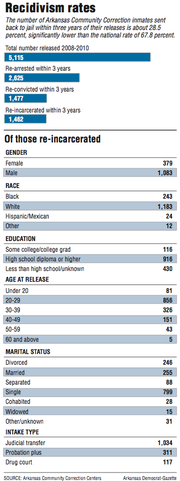More than a quarter of inmates released from the Arkansas Department of Community Correction were re-incarcerated within three years, according to a new report.
Of the 5,115 inmates released between 2008 and 2010, about 28.5 percent or 1,462 were re-incarcerated within three years, according to the report and agency statistics.
"The report is a gauge we use to determine if we're on the right track," said Dina Tyler, a deputy director of the Community Correction Department. "It allows us to deter some trends.
"We are able to unpack and look in there to see what we have. Let's say that we know females have a lower recidivism rate than males. We know that we've got to do something to address the males specifically because something's not working."
The report comes at a time when the state's prisons and other detention facilities are at overcapacity, which is putting a financial strain on the judicial system's punitive options.
The number changes every day. But data show there are about 20,999 state prisoners. At an average cost of $70 per day per inmate, the tab comes to $536.5 million annually.
The state's five community correction centers, which hold about 1,300 beds, are residential facilities that identify and treat underlying disorders that may be contributing factors to an offender's criminal behavior -- such as drug and alcohol use or mental illness.
Arkansas Code 16-903-1202 sets acceptance criteria for inmates at the centers, and include nonviolent and non-sex-related offenses.
Drug and alcohol treatment and behavior modification as well as educational and vocational programs are offered at the centers. Life skills like anger management, cognitive skills training, parenting, violence prevention and socialization also are taught.
Arkansas has three detention agencies -- the Youth Services Division, the Department of Correction and the Department of Community Correction.
The Community Correction Department's "Measuring Recidivism" report -- which was compiled internally by department researchers using data gathered from the department's Electronic Offender Management Information system and from the Arkansas Crime Information Center's Uniform Crime Reporting Program -- is the first of its kind for the department.
Recidivism is a criminal act that results in the rearrest, re-conviction or re-incarceration of a person with or without a new sentence during a three-year period.
The department has tracked recidivism in the past, but the reports were based on a fiscal year instead of a calendar year. Officials said they were not as encompassing of all the data now available and were produced -- for a significant cost -- by an outside agency. Reports from now on will be calendar year.
"We need to know what is going on," Tyler said, "How do you know if what you're doing is working if you don't measure it? This is a jumping-off point for us. You have to start somewhere."
State Sen. Jeremy Hutchinson, a Little Rock Republican and chairman of the state's Criminal Justice Oversight Task Force, said that legislatively the trend will be toward requiring more and more data from the state's corrections system.
Hutchinson said Sheila Sharp, director of the Community Correction Department, and Wendy Kelley, director of the Arkansas Department of Correction, are data driven.
"Data is extraordinarily important," Hutchinson said. "For decades we've been making policy decisions based on the news cycles or high emotions. That's resulted in seesaw policymaking where we go from one extreme to another. It has not been effective.
"Starting last session, we have really examined the data and are trying to come up with policies that are smart, not just in response to political winds."
The subcategories of the report illustrate where trends can be spotted and solutions aimed, Corrections Board Chairman Benny Magness said.
He pointed, in part, to the disparity between whites and blacks admitted to the program.
"We have to find a way to give other races more opportunities," Magness said.
The typical community correction inmate, according to the report, is a white man, under 29 years old, has a high school diploma and is single.
Of the 5,115 inmates released from 2008 to 2010, more than 77.6 percent, or 3,974, were white; 68 percent, or 3,476, were male; 49.5 percent, or 2,533, were between the ages of 20 and 29; 58.5 percent or 2,992, held a high school diploma; and almost 48.5 percent, or 2,485, were single.
Only 19.4 percent or 992 of those released during the report period were black and 2.2 percent or 111 were Hispanic.
Whites are a higher percentage of those inmates re-incarcerated within three years of release. The report showed:
• Of the 3,974 whites released from a community correction center, 1,183, or 29.8 percent were re-incarcerated.
• Of the 992 blacks released, 243, or 24.5 percent, were re-incarcerated.
• Of the 111 Hispanics released, 24 or 21.6 percent were re-incarcerated.
About 80 percent, or 4,094, of the inmates in the community correction centers were transferred from the Department of Correction. Sixteen percent, or 813, were sentenced by judges to "probation plus," which consists of a probation term with an additional period of confinement at a center. About 4 percent, or 208, were sentenced to the centers by drug court judges.
Hutchinson said there is a strong commitment "from the governor's office to the Legislature" to continue existing programs and to expand opportunities for access.
"I believe there are two keys to reducing recidivism: getting the treatment and finding them a job," Hutchinson said. "We're moving towards building re-entry facilities where we will be focused on giving them job skills and engaging the faith-based community."
Gov. Asa Hutchinson's prison plan, unveiled in February, calls for 500 beds for soon-to-be parolees at regional "re-entry centers" where inmates would undergo training and treatment.
The report shows that those inmates who are dually diagnosed -- meaning they have a drug dependency problem as well as a mental-health diagnosis -- are re-incarcerated at a much lower rate than the general Community Correction center inmates.
Two of the state's facilities, the Southwest Community Correction Center for men and the Southeast Community Correction Center for women, operate what the agency calls special-needs programs. Inmates there receive different programming from the general population, including 10 hours of mental-health treatment per week.
Of the 1,465 special-needs inmates released during the reporting period, 354, or 24.2 percent, were re-incarcerated. This compares with 1,108, or 30.4 percent of no-special- needs inmates who were re-incarcerated over the same period.
David Montague, a former federal Drug Enforcement Administration investigator and a criminal-justice professor at the University of Arkansas at Little Rock who specializes in re-entry and recidivism, said the state is on the right track. A volunteer in the Arkansas prison system for more than 12 years, Montague said he has personally seen the growth and a culture change in the corrections system.
"We're proud of that Arkansas is a more conservative state, but there's a growing sense of commitment to trying to help people from recidivating," Montague said. "There is a nice cadre of folks in the state corrections system. In the last three years, both departments have hired a deputy director for re-entry. That's a phenomenally positive shift. It sends a message from the very top that we value this."
The key for the future, Montague said, is increasing and improving the conversation between all agencies and the community.
"We have to work at getting the different stakeholders to talk to each other. It's somewhat of a growth process that's happening right now," Montague said.
"We need to have more education in the community. They need to understand that those who they bump into day in and day out could have been incarcerated. They bring valuable skills back to the communities. Increasing that education and understanding brings more power and we're more successful at keeping inmates out of jail."
Jeremy Hutchinson, the state legislator, said he is "very excited about the direction" the state is headed.
"It has been a 180-degree turn from where we've been going," he said. "I also don't want to oversell our promise. This will be a method of continual improvement."
A Section on 06/24/2015

